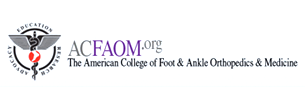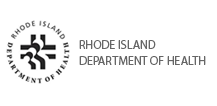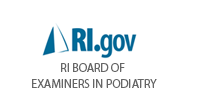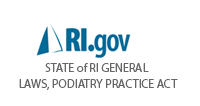Infection Control Recommendations for the Podiatric Physician’s Office
This report is based on the recommendations of the Centers for Disease Control and Prevention and other publications in the medical literature. The recommendations here are intended to offer general guidance for podiatric medical offices on infection control. They are not intended to establish a standard of care or industry custom.
Podiatric physicians are exposed to a wide variety of microorganisms in the blood of patients. These microorganisms may cause infectious diseases such as hepatitis B (HBV), and acquired immune deficiency syndrome (HIV). The use of effective infection control procedures and universal precautions in the podiatric physician’s office will prevent cross-contamination that could extend to doctors of podiatric medicine, podiatric medical office staff and patients.
Doctors of podiatric medicine should recognize an important distinction between OSHA requirements and acceptable infection control practices. OSHA has a Congressional mandate to institute workplace procedures that protect the employee, and, by law, is able to write regulations and enter the workplace to conduct inspections and impose financial penalties. The 1991 OSHA Standard on Occupational Exposure to Bloodborne Pathogens is thus written to protect employees. OSHA does not have the mandate to institute practices that protect the patient or the employer.
Universal Precautions for Infection Control in the Doctor of Podiatric Medicine’s Office
A thorough medical history should be taken for all patients at the first visit and updated and reviewed at subsequent visits.
However, since not all patients with infectious diseases can be identified by medical history, physical examination or readily available laboratory tests, the CDC has introduced the concept of universal precautions. This term refers to a method of infection control in which all human blood and certain human body fluids are treated as if known to be infectious for HIV, HBV and other bloodborne pathogens. Universal precautions mean that the same infection control procedures are used for all patients.
Barrier techniques. Gloves must be worn when skin contact with blood and body fluids is anticipated, or when touching items or surfaces that may be contaminated with blood and body fluids. After contact with each patient, gloves must be removed and hands must be washed and then re-gloved before treating another patient. Repeated use of a single pair of gloves by disinfecting them between patients is not acceptable.
The use of protective clothing, such as gowns, aprons, laboratory coats or similar outer garments,
either reusable or disposable, must be worn when clothing or skin is likely to be exposed to blood and/or body fluids. Protective clothing should be changed when visibly soiled or penetrated by blood and/or fluids. OSHA requires that these garments not be worn outside the work area and that protective attire be removed and placed in laundry bags or containers that are properly marked after use.
The use of masks, such as surgical masks or plastic face shields and the use of protective eyewear must be worn to protect the face, eyes, and nasal passages when spatter of blood is anticipated. Masks should be changed when visibly soiled or wet. Face shields and eyewear should be cleaned when necessary. The OSHA Standard specifies that protective eyewear should be fitted with solid shields.
Avoidance of Contamination
Hands must be washed at the beginning of each day, prior to gloving, and after removal of gloves. Hand washing facilities should be designed to avoid cross-contamination at the sink and soap dispensers.
Sterilization and Disinfection
Sterilization is the process by which all forms of microorganisms including viruses, bacteria, fungi and spores are destroyed. Suitable methods of sterilization include the use of steam under pressure (autoclave or pressure cookers), dry heat, glass bead, ultrasonic cleaners and chemical vapor. Immersion in a cold chemical sterilant solution instead of the use of physical means of sterilizations is not recommended because the sterilization by chemical solutions cannot be monitored biologically, and instruments sterilized by chemical solutions are not wrapped, therefore, must be used immediately or stored in a sterile container.
Disinfection is generally less lethal to pathogenic organisms than sterilization. The disinfection process leads to a reduction in the level of microbial contamination and covers, depending on the disinfectant used and treatment time.
Disinfection may be accomplished by using a chemical disinfectant according to the directions on the product label. When chemical solutions are used for disinfection, manufacturers’ instructions must be followed carefully. Particular attention should be given to dilution requirements (if any), contact time, temperature requirements, antimicrobial activity spectrum and reuse life.
Instruments and equipment
Surgical and other instruments that normally penetrate soft tissue or bone must be sterilized after each use or discarded. If instruments are to be stored after sterilization, they should be wrapped or bagged before sterilizing using a suitable wrap material. The wrap or bag should be sealed completely prior to sterilization. Process indicators should be used for sterilization. After sterilization, the instruments should be stored in the sealed packages until they are used.
Instruments and equipment that come in contact with intact skin, that may be exposed to blood and/or body fluids or that may have been touched by contaminated hands should be disinfected.
Instruments and equipment intended for sterilization or disinfection procedures must first be carefully prepared. Patient debris and blood must be removed from the instruments and surfaces before sterilization or disinfection. After cleaning, the instruments should be dried before being wrapped or packaged.
The APMA advocates that podiatric physicians frequently clean their stethoscopes and take all reasonable precautions with their other hand-held instruments in order to minimize the potential risk of nosocomial infection.
Disposal of Waste Materials
Disposal of waste materials, such as gloves, masks, wipes, paper drapes and surface covers that are contaminated with blood and/or body fluids should be carefully handled with gloves and discarded in sturdy, impervious plastic bags to minimize human contact. Blood, disinfectants and sterilants may be carefully poured into a drain connected to a sanitary sewer system. Care should be taken to ensure compliance with applicable state and local regulations. Sharp items, such as needles and scalpel blades, should be placed in puncture-resistant containers marked with the biohazard label (sharps) and be disposed of according to the requirements established by local or state environmental regulatory agencies. Human tissue may be handled in the same manner as sharp items, but should not be placed in the same container and be disposed of in accordance to requirements established by local or state environmental regulatory agencies.












